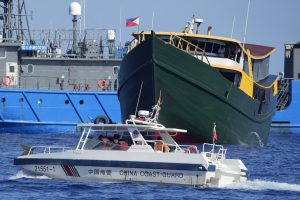In a high-stakes diplomatic cable in the early 1970s, then-U.S. Secretary of State Henry Kissinger argued that “there are substantial doubts that [a Philippine] military contingent on island in the Spratly group would come within protection” of the Philippine-U.S. Mutual Defense Treaty (MDT). Kissinger counseled Washington to only provide “helpful political actions” but refrain from militarily backing Manila in the event of a conflict among claimant states in the South China Sea.
The chief U.S. diplomat insisted that “[we] do not see legal basis at this time, however, for supporting the claim to Spratlys of one country over that of other claimants,” thus officially commencing half-a-century of American “strategic ambiguity” on one of the world’s most consequential maritime disputes. Emphasizing the need for “neutrality,” Kissinger was adamant that the Southeast Asian nation should not be allowed to exploit its treaty alliance with a superpower for the purposes of territorial self-aggrandizement.
Crucially, he even questioned the basis of Manila’s claims in the area, since “[Philippine] occupation could hardly be termed uncontested in face of claims and protests of Chinese and Vietnamese.” He argued that “[c]ontinuous, effective, and uncontested occupation and administration of territory” is the ultimate basis of determining ownership over disputed land features.
Nevertheless, Kissinger sought to reassure the Ferdinand Marcos regime by offering concrete military assistance, albeit with certain caveats, under certain contingencies. Specifically, he clarified that the “MDT may apply in event of attack on [Philippine] forces deployed to third countries,” although this is “fundamentally different from [a] case where deployment is for purpose of enlarging Philippine territory.” Still, the Nixon administration – and its successors well into the end of the 20th century – only generically mentioned the “Pacific” theater without specifying the South China Sea as a locus of the MDT, thus insisting on a strict position of neutrality on the status of disputed land features in the area.
Four decades later, U.S. President Barack Obama, during a historic visit to Manila, repeatedly refused to clarify whether the MDT applied to Philippine disputes with China in the South China Sea just days after making it clear that Japan can rely on Washington’s full support in the event of conflict over disputed features in the East China Sea.
Just two years earlier, the Obama administration also refused to squarely stand by the Philippines amid the months-long standoff over Scarborough Shoal in 2012. This effectively mirrored the policy of the Clinton administration, which shunned any military intervention in the mid-1990s when China seized the Philippine-claimed Mischief Reef.
What’s often overlooked in the historical analysis of the South China Sea disputes is how the Philippines’ proactive efforts at consolidating its claims in the area forced Washington to double down on its strategic ambiguity.

































